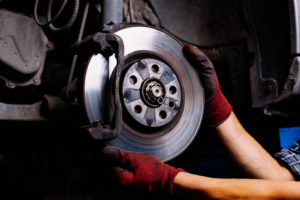Did you know that during a tire rotation, our ASE certified technicians routinely perform an inspection of your brakes? Maintaining your braking system is essential to safe driving and upkeep of your vehicle. We inspect the condition of your brake rotors and note any corrosion. Excessive corrosion limits the amount of contact between pad and rotor. This reduces the stopping power of the vehicle. Tech’s also measure the thickness of the brake pads and verify the wear is even across the length of the pad. Uneven pad wear is indicates a potential problem with the brake caliper. Hoses are visually inspected for worn areas and possible leaks.
Have one of our technicians perform a thorough brake inspection if you notice any of the following when braking:
- Hearing noise(s) when applying the brakes
- Feel a pull to one side while braking
- Vibrations in the pedal or steering wheel when applying the brakes
- Brake light is illuminated on the dashboard
- Brake pedal pushes all the way to the floor
Brakes are designed to be a wear-item, the parts are meant to wear and be replaced. Depending on drive style, road conditions and type of brake materials, the wear may be slow or rapid. Be cautious of anyone who tries to sell you a lifetime warranty. The adage “if it sounds too good to be true, it probably is” is applicable when it comes to lifetime warranties on brakes.



